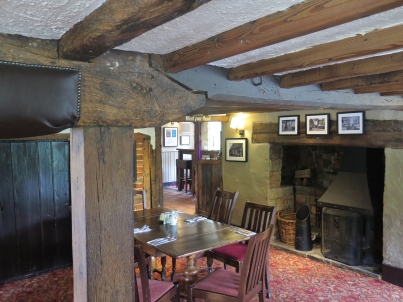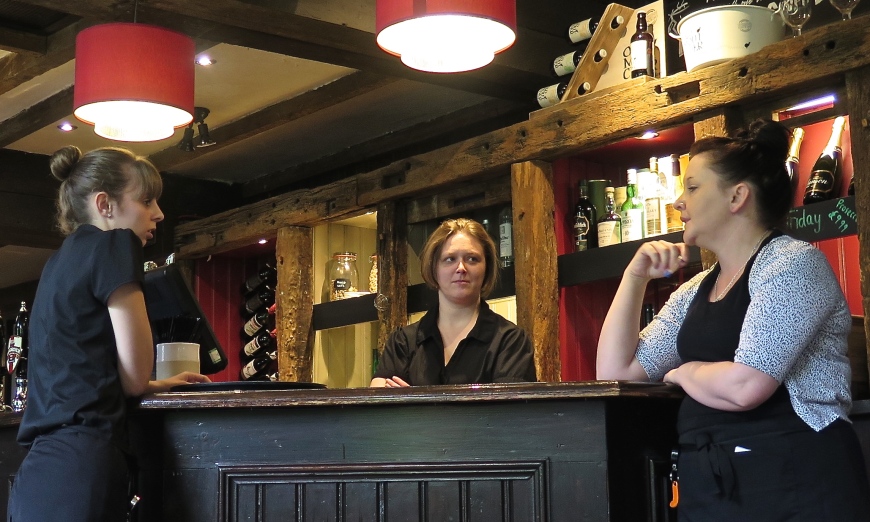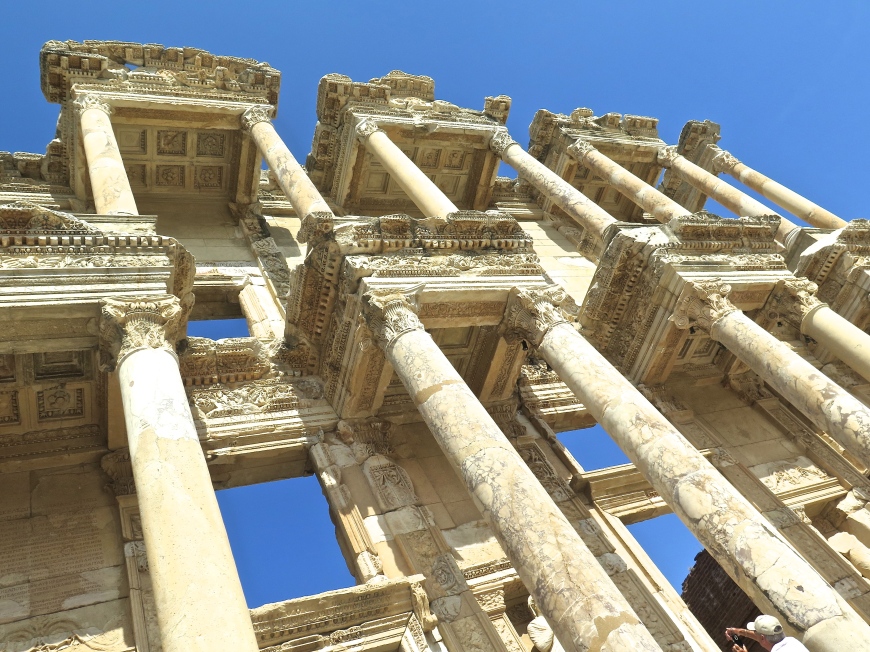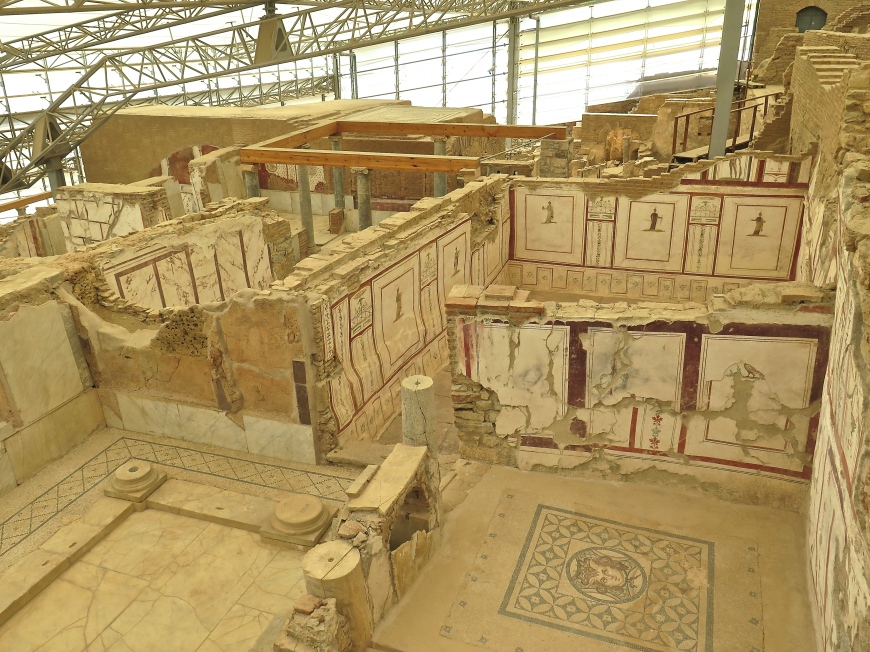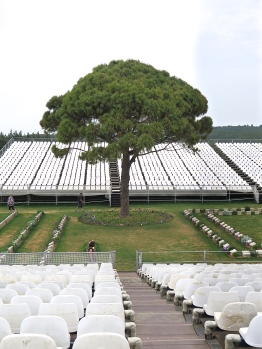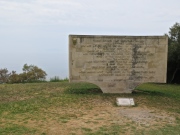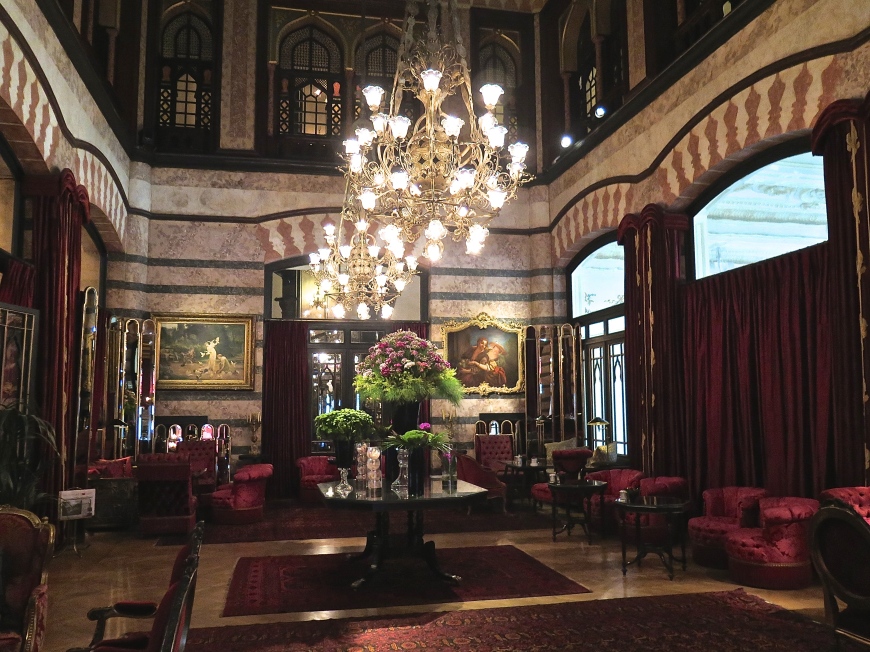 A class of Serbian kids on the steps of St Sava.
A class of Serbian kids on the steps of St Sava.
We arrived in Belgrade and it was raining for the first time since we had left home.
The road from the airport to the old city is a highway through the new-ish and ordered suburbs on the west bank of the Sava, the Pannonian Plain side of Belgrade. Light industry, government buildings, tower blocks, wide streets. You cross the Sava and you’re in the Balkans. There was a bit of ducking and weaving through the old town — graffiti ubiquitous, mostly football team and Kosovo related we were told — and there we were, at 88 Rooms, Ulica Takovska.
It was work experience day at the desk which produced a fair amount of fumbling. As can happen, an older girl/young woman held the keys to the kingdom, knew everything, fixed everything, organized everything. 88 Rooms is a new building in an old area.  This was the view out our window. The hotel was new but not well made — cheap materials, careless work. The strike plate of our door lock fell off as we opened it. Too much drilling had left no wood for the screws to bite. A bit of that.
This was the view out our window. The hotel was new but not well made — cheap materials, careless work. The strike plate of our door lock fell off as we opened it. Too much drilling had left no wood for the screws to bite. A bit of that.
We walked down to Skardalija, the liveliest bit of a lively city.  Down this street.
Down this street.
Past these men.

But not yet these men. What champs.

To here.
It looks like a Tourism Belgrade photo but it’s no fake. That’s how it was. The heart of good cheer and great Balkan music. Serbian music I’d better say. Our waiter at Dwa Jelena (Two Deer, founded in 1832 by hunters who came in with … so the story goes. Džejmi Oliver has cooked there.) couldn’t have been more helpful. Long day, big trip, first night new city, the chances of making a complete dick of yourself are profound.
 He found us some nice wine, excellent bread, a good salad and this dish: four or five types of grilled meat on a bed of roast potatoes. Not complicated, very well rehearsed — probably sell 120 of those a night — but delicious. Then he talked us into having some cherry pie. This cherry pie became the benchmark for all culinary experience, subsequent and previous. We went back for another one a night or two later and it was ordinary. Isn’t that just life.
He found us some nice wine, excellent bread, a good salad and this dish: four or five types of grilled meat on a bed of roast potatoes. Not complicated, very well rehearsed — probably sell 120 of those a night — but delicious. Then he talked us into having some cherry pie. This cherry pie became the benchmark for all culinary experience, subsequent and previous. We went back for another one a night or two later and it was ordinary. Isn’t that just life.
We had a terrific night, walked home and slept like a log in a good Serbian bed. I had organized a guide for the morning, a couple of hours round Belgrade.
•• •• •• ••
The correct name for Belgrade, our name, is Beograd or White City. There are many ideas for its source, but I think for the walls of the magnificent fort where the rivers Sava and Danube connect. Perhaps also for the beauty of the many buildings which have been destroyed over the years.
The history of White City begins 9000 years of continuous occupation. It has been called Singidun and some people say that it was established by Celtic invasions from central Europe [from the Halstatt people in 279 BC. ‘Dun’ is Celtic for ‘fort or ‘town’.]. The Romans were here [first and second centuries AD, and called it Singidunum] but there is good evidence to say that the occupation of this area by Serbs has been continuous over 9000 years. Some people say it was the invasion of the Slavs from the north, but I believe the Serbian Slavs were probably here already.
You must understand this is our home. We were here first and always.
 Republic Square. This is where we gather when we are happy, or sad. Or angry. Serbs will always tell you how they feel. Our language has been described as the purest and easiest to manage of any. Can you hear the music in it? I think you find it so. These streets we are in, Belgrade streets, are renowned as the safest in the world. We have no trouble here. This is interesting and ironical because many people also say we are the best fighters.
Republic Square. This is where we gather when we are happy, or sad. Or angry. Serbs will always tell you how they feel. Our language has been described as the purest and easiest to manage of any. Can you hear the music in it? I think you find it so. These streets we are in, Belgrade streets, are renowned as the safest in the world. We have no trouble here. This is interesting and ironical because many people also say we are the best fighters.
Nicola Tesla Museum.  Nicola Tesla was an authentic Serbian genius. He is the father of alternating current and many dozens of patents of universal importance. He is proof of the quality of Serbian scientific thinking. [Tesla: born to Serbian parents in a Croatian town, went to university in Graz, Austria, lived in Slovenia and Czechoslovakia, migrated to the US at the age of 28, became a naturalized US citizen at the age of 35.] Like many of our achievements no one gives us credit for what is obvious. So much so, you could suspect that it is part of a deliberate plot. I don’t say that it is. I just want to tell you what I think you need to understand.
Nicola Tesla was an authentic Serbian genius. He is the father of alternating current and many dozens of patents of universal importance. He is proof of the quality of Serbian scientific thinking. [Tesla: born to Serbian parents in a Croatian town, went to university in Graz, Austria, lived in Slovenia and Czechoslovakia, migrated to the US at the age of 28, became a naturalized US citizen at the age of 35.] Like many of our achievements no one gives us credit for what is obvious. So much so, you could suspect that it is part of a deliberate plot. I don’t say that it is. I just want to tell you what I think you need to understand.
For example, you must understand that Belgrade has been destroyed by war and razed to the ground 44 [or depending on the source 38 or 52] times, and every time the spirit of the Serbian people and our determination to preserve our homeland has meant that it was rebuilt. Do you know any other city in the world that could say that? More than 40 different armies have tried to conquer Serbia, and we have outlasted them all. Even though many of our most beautiful and historic buildings are no longer, the soul of Belgrade is immortal. That is what the empirical evidence tells us.
We are a small people who as a Serbian poet has noted have the bad luck that our forefathers ‘built a home in the middle of the road’. Many centuries ago, they settled in the middle of Balkans, in the middle of the main road that leads from Central Europe to Central Asia, the Middle East and North Africa. It is the southern flank in any invader’s attack on Russia. To invade any country, to win any war in Europe, or the Middle East you must go through Serbia. It is the crossroads of the world, and yet our identity is still very strong.
And now the basilica of St Sava, for me the heart and soul of Belgrade.

After fighting his brothers, Stefan Nemanja came to the throne in 1170. He had the title of ‘veliki zupan’. [like ‘prince’. He later became ‘Despot’, which has a technical meaning quite unlike its common usage in English. We spent quite a lot of time walking down Despot Stephen Street.] He began restoring the Serbian state in the Raska region and constructed many monasteries.
Stefan Nemanja’s successor was his middle son Stefan, while his youngest son Rastko became a monk, taking the name Sava, and dedicated himself to spreading religion among his people. In 1217, Stefan asked the Pope for the crown and became the first Serbian king. In 1219 his brother Sava secured the autocephalous status of Serbian church and became the first Serbian archbishop.  He is St Sava, the Sun of Serbian Heaven.
He is St Sava, the Sun of Serbian Heaven.
Autocephalous? Self head. There is no other boss. Not the Pope. Not the Archbishop of Canterbury; the Patriarch of Serbian Orthodox church is the head of Serbian Orthodox Church. Since 1219. Longer than you can know. Christian ethos becomes Serb ethnos. [Mark well those words.]
In 1594 the Serbs staged an uprising in Banat, the Pannonian part of Turkey, really Serbia, and Sultan Sinan Pasha retaliated by burning the remains of St. Sava, the most sacred thing for all Serbs honored even by Moslems of Serbian origin. The remains were brought from the Mileševa monastery in South Serbia and were burnt at this plateau, the most prominent in Belgrade, so that as many people as possible would know of this thing, the most bitter act of Ottoman history. However the remains did not turn to ash, but into light. This is true even in a semi-literal way. This light still warms the heart of the Serbian people.
We now build a cathedral according to our own Serbian Byzantine style on this site.
In 1895 a society of foremost citizens was formed to build this cathedral. This began truly in 1935, 340 years after the atrocity. I will tell you something interesting. The first and third prizes for the design were not awarded. The design which received second place was chosen.
During the war work ceased. The Nazis used this place as a parking lot, then as fortified defence. Later it was used for storage. Since Patriarch German, that is his name, 88 requests to continue building have been made for 87 refusals to change our ‘weeping walls’. But building began again in 1985. 100,000 people came to the re-opening.
You see the dome 70 metres from the ground and 134 metres above sea level. The height of the cross is 12 metres higher again. This is one of the biggest and most beautiful church buildings in the world. More than 10,000 people can be inside at any one time. Inside will be white marble with mosaic telling all of Serbian history. The white cathedral for the white city. It is not just a church; it is a national monument and national symbol. It speaks to us every day that we must be ready for self sacrifice. [What did he say? Christian ethos becomes Serb ethnos? Exactly.]
You notice something now we are inside. Can you see? No pillars. The dome was built on the ground and raised into place taking 40 days. This is one example of excellent Serb engineering skills.
I’ll tell you one story to make you weep. It always has a big effect on me. Rich American Serbs, there are many rich Serbs spread across the world, even in Australia, say we will give you the money to finish the church, many millions. Here. Have it. The people of Belgrade say no, we will get our money over time. We will sacrifice. The Patriarch says, we have waited 400 years to build this cathedral. We are happy to wait 400 more.
We say, St. Sava Church does not belong to anyone; we belong to it. It is built by all times and by all generations, by our Patriarchs, ancestors, forebears and fathers. There are four s’s on our cross, standing for: Samo sloga Srbina spašava (‘Only unity saves the Serbs’).
•• •• •• ••
St Sava’s is not finished and has a rather eerie pre-stressed concrete/ plastic drop sheet feel inside. This will be changed for good or ill by several acres of mosaic.
 Another guide walked past with her croc of tourists, but she went downstairs to the crypt. She was a friend of our guide’s and we tagged along, as it turned out, a very special favour. The crypt is another proposition entirely, a product of patient and beautiful decoration. And she sang. She was a musician by training with an angelic voice which resonated through the subterranean spaces. It was quite a transcendent experience.
Another guide walked past with her croc of tourists, but she went downstairs to the crypt. She was a friend of our guide’s and we tagged along, as it turned out, a very special favour. The crypt is another proposition entirely, a product of patient and beautiful decoration. And she sang. She was a musician by training with an angelic voice which resonated through the subterranean spaces. It was quite a transcendent experience.
•• •• •• ••
Was Yugoslavia a good idea?
For me to answer that question I must sit down with coffee. [Magnifico Coffee, warm attentive service, great coffee, great cakes which we weren’t allowed to have until the lecture finished.]
First you must understand that the Serbian people are the real Slavs. Croats have the same language just different script, same background, same culture but they have been corrupted by their contact with western influences over many centuries, many times by fascistic movements. In Bosnia there are some leftover people from the Turkish invasion but really they are Serbs who were willing to do all the dirty jobs and who wanted to turn their coats and become Muslim.
The people who are not Serbs are the people who now have our most sacred possessions. The Albanians in Kosovo. They come from Asia near Azerbaijan. They have no part of our culture but they have our monasteries and our sacred places, including the most sacred place of all.
 To understand the Serbs is to understand their sense of pride. It is to understand why the Serbs celebrate June 28, St. Vitus Day, the day of the Kosovo Battle of 1389. Those who hate the Serbs claim we are a sick people who celebrate a day of defeat.
To understand the Serbs is to understand their sense of pride. It is to understand why the Serbs celebrate June 28, St. Vitus Day, the day of the Kosovo Battle of 1389. Those who hate the Serbs claim we are a sick people who celebrate a day of defeat.
The Serbs do not celebrate this as victory or defeat. They celebrate the bravery, the pride of their forefathers who came to meet on the battlefield the intruder to their homeland. It did not matter that the advancing forces were immense. To protect their way of life, to protect their families, to protect freedom, all Serbian nobility came to fight. Most of them died on that day, June 28, 1389. Since that day the Serbs firmly knew that freedom has no price. Many Serbs, through generations and time, happily sacrificed their lives for freedom.
[The actual battle appears to have a been a particularly bloody draw. Both the Serbian King and Turkish Sultan perished, along with most of both sides. A relentless battle.]
Belgrade Red Star supporters at a soccer match. To hear them sing ‘The Hymn of Kosovo’, click here. It may be possible that the 1990s Balkan wars started at a Red Star/ Zagreb Dynamo game. To investigate further click anywhere here and scroll through.
If you have any interest in this topic the mood of it is wonderfully rendered in this series of very fine narrative poems. From the Introduction: ‘Serbs are possibly unique among peoples in that in their national epic poetry they celebrate defeat. Other people sing of the triumphs of their conquering heroes while the Serbs sing of the tragic sense of life.’]
This sacrifice stopped the Muslim invasion of Europe for 70 years. Are the grateful nations the ones who bomb our city and who slander our name in illegal tribunals? Our forefathers never fought to grab other people’s lands. Our forefathers never fought to impose our culture, our way of life or our language or religion on anyone. We fight for freedom, for the simple right to exist.
The Hague ‘Tribunal’ is not the first time that a conqueror attacks the Serbs as physical beings, but also attacks their pride. That is why, exactly on June 28, 1914, June 28 you understand, Prince Ferdinand, the Austrian heir to the throne, decided to have military maneuvers in Bosnia, then a majority Serbian province which the Austro-Hungarian Empire had illegally annexed six years before.
The Serbian answer was to assassinate Ferdinand. That is how World War I started, remember? Fifty percent of the Serbian male population died in that war. Every second man. The story of that Serbian sacrifice should be in every history book. That was the price the Serbs were ready to pay.
Milosevic? Milosevic was criminally insane. He is now dead, but his wife I believe is in Russia with many millions, billions even of money stolen from the Serbian people. This is one reason why we are so poor. The others are Clinton and NATO. But you must understand that our task in that war [1990s] was to protect Serbian people in the areas where they were living in many cases as majorities, but often under daily attack from their neighbours.
Is it not right under international law that a country has the right and the responsibility to protect its citizens? The same is true of Kosovo. Kosovo is the cradle of our heritage and spirituality. This is the location of the Blackbird Field which gives meaning and purpose to the Serbian nation — in Kosovo, part of Serbia. The eradication of the Serbian people and our culture in Kosovo is an attack on the overall European cultural heritage and tradition.
You probably do not know that the Albanians who have overrun Kosovo are not Balkan people. They are Asian. Their real name is Shqiptars and their origins are somewhere near Azerbaijan from where they have been driven. They have a reputation as thieves and smugglers and as criminals. They have Mafia who attack Serbs and destroy their property. And [by declaring their independent status] they have done something illegal directly against the spirit of international law. Does Spain make the Basques a separate country? Does Germany think that Bohemia or Bavaria should be a new nation? England says no to Scotland becoming separate. And yet they are happy to spread lies and propaganda about the Serbs in their most sacred country, 20 percent of Serbia.
Srbenica? It is war. Bad things happen in war. Always, by everyone. But this is a big propaganda tool. All the talk about Srbenica but you forget. During the war the Ustashe regime [installed with the support of the Italian Fascists as the government of Croatia] killed no one knows how many but tens of thousands of Serbs. Their lives were obliterated without trace. Two hundred and fifty thousand were expelled, and 200,000 forcible conversions to Catholicism occurred. We know this. It is our history. We live with it every day. Does anyone in the west talk about this? Is that in your newspapers?
August 4 we have the anniversary of the Croatian attack on the Serbian majority region of Krajina in 1995 that resulted in the expulsion of 200,000 to 300,000 Krajina Serbs. This was the largest population displacement during the Yugoslav breakup in the 1990s. It was the largest expulsion in Europe since World War II. Maybe the largest act of ‘ethnic cleansing’ since the Holocaust. In 1997, the names of 1,542 Krajina Serbs killed in the assault were recorded. Over 73% of the houses of Krajina Serbs were destroyed. The Krajina expulsion was an act of genocide not seen in Europe since World War II.
Do you read about that in your western newspapers? The US and Western media referred to it as an ‘exodus’ and an ‘assault to oust Serbian rebels’, ‘Croatian Serbs’, the oxymoron propaganda term developed by the US State Department. These facts been covered-up and deleted from the mainstream history of the Balkan conflicts because the victims were Serbs and because a majority population was destroyed and denied self-determination.
 Do you like to sit still as NATO bombs of the colonialist powers rain on your head?
Do you like to sit still as NATO bombs of the colonialist powers rain on your head?
I am not certain but I have the opinion Serbs are proof of what the great psychologist Carl Gustav Jung called the ‘collective unconscious’, the collective unconscious that causes a people to rise up and claim what is theirs. Sometimes violence is necessary for this to occur. We don’t shy away from that. What is our alternative?
•• •• •• ••
He left us in Prince Michael Street. It had been quickfire, fierce and exhausting.
This is one of those listening processes where you begin by thinking: oh that’s interesting, here’s a new insight — he was a nice guy, very well educated in a particular fashion, speaks more languages than I do, has lots of experience. Then move along to thinking, my goodness, is that how all this is constructed? At least it is a consistent world view even if it’s been punched a bit out of whack. And then you end up thinking just, gosh.
We walked slowly down through a lively main street where people were shopping eating drinking and enjoying themselves. It looked quite normal.
 We stopped at the ‘?’ café because it was on the way to where we were going — the rivers and the fort — and looked just fine. ‘?’ because for many years it was known as ‘By the cathedral’ café and then the cathedral objected. So, hands thrown in the air — ‘?’ Stylish, professional service, happy to cater for our every (modest) whim. The last word in friendliness.
We stopped at the ‘?’ café because it was on the way to where we were going — the rivers and the fort — and looked just fine. ‘?’ because for many years it was known as ‘By the cathedral’ café and then the cathedral objected. So, hands thrown in the air — ‘?’ Stylish, professional service, happy to cater for our every (modest) whim. The last word in friendliness.
 Just because … Isn’t he cute?
Just because … Isn’t he cute?
That night we spent a lot of time trying to find a particular restaurant. Our problems could be explained by two salient matters. 1) It was a vegetarian restaurant, very Serbian actually but voluntary vegetarianism is improbable in Belgrade, and 2) it was called Radost Fina Kuhinjica, ‘Nice Little Kitchen’, and so it very much proved, but people had trouble getting a grip on such a generic name, and, hidden away in the back of an apartment block, even people living right next door didn’t know it was there. We were treated with great interest, warmth and generosity and super food and, on advice from a delightful young waiter, otherwise an engineering student, Ergo Temet wine. Chase it down. A small Serbian miracle.
•• •• •• ••
Next day. Different guide. Same story.
We wanted a look at the Serbian countryside. Mike was interested from all sorts of perspectives; among other things he’s a farmer grazier. The tour fitted. It was a drive up to the city of Novi Sad (‘New Present?’ ‘Today City?’) further upstream on the Danube across the laser-flat Pannonian Plain with a deviation through the hills of the Fruska Gora. On the way we visited Krušedol monastery. 
Two patriarchs of the Serbian church are buried there.
 Some Serbian kids at Krušedol.
Some Serbian kids at Krušedol.
I think Joci knew very little about Krušedol except that it was old and Blind Freddy could see that. The interior had some very fine murals that he had trouble explaining.
‘After Kosovo (ie 1389) it was very important for the Serbs to have their own religious figures. So for the Virgin Mary we have St Angelina, for St Peter we have … and St John … These are the great figures of Kosovo.’ You mean you have Serb substitutes for the whole group of major Christian figures? ‘Yes we do.’
I didn’t pursue this. It might have been a language issue, and I didn’t really want him to tell me anyway. It was getting weird.
Earlier I had asked him what the process of change had been from going from collectivised farming to privately held farms to the giant industrialised concerns we were driving through. ‘To understand this process you must understand the Serbian people and their relationship with the land, and this really begins at Kosovo 626 years ago. This is when we became a nation …’ Thirteen minutes later he was still going. I timed him just out of interest. We had been through the Albanians, the NATO bombing, the importance and delights of Krsna Slava — the celebration of a family’s saint’s day — the quality of Serbian family life. Then I reminded him of the question which he had forgotten.
It’s not an easy question, but I just wanted impressions, not a detailed answer. He’d lived through the experience. And there is always the option of saying I don’t know. But he was Serbian, proudly and emphatically, and this is why he was telling us what he thought we needed to know, what we had to know.
‘You are Scottish?’ Well, not me really. My ancestors … a long time ago, 150 years ago. ‘That is a short time really. What do you think of what the English have done to your homeland? Don’t you feel angry about that? Do you not want to seek revenge?’
•• •• •• ••
We stopped at Sremski Karlovci, the centre of which is a Spatial Cultural-Historical Unit of Exceptional Importance. Some idea of its history can be gained from the facts that in Croatian it is known as Srijemski Karlovci, in German as Karlowitz or Carlowitz, in Hungarian as Karlóca, in Polish as Karłowice, in Romanian as Carloviț and in Turkish as Karlofça.
 Saved by the need for a cup of tea! It was such a relief. If you’re walking around you can drift off on your own, but in a car there is no escape. But moreover immediately in front of us was an orkestar, one of the things I love about the Balkans, which might have been going to play. (‘Underground’: such a Serbian film. Too long, but a monstrous tour de force. Five and a half stars.)
Saved by the need for a cup of tea! It was such a relief. If you’re walking around you can drift off on your own, but in a car there is no escape. But moreover immediately in front of us was an orkestar, one of the things I love about the Balkans, which might have been going to play. (‘Underground’: such a Serbian film. Too long, but a monstrous tour de force. Five and a half stars.)
We sat down in the square and I asked Joci to show us just where Kosovo was using his phone. He couldn’t find Kosovo on the map. And that is true. That was Serbia sure, but which way was Kosovo? He scuttled off to buy a paper map and rather absently — the day was balmy and I was out of the car — I noticed a crowd gathering. I am looking at the photos now and in a crowd of two to three hundred I can see only three women. A lot of the men were relatively young. They were quiet and focused, their attention fixed on a door in a large building on one side of the Square. Joci came back and I asked him to find out what was going on.
The building was the Clerical High School of Saint Arsenjie (Sava’s successor) and we were on the brink of the final part of the graduation ceremony to the Serbian priesthood for every single successful candidate for 2015.
 At midday a bell tolled and the crowd drew up taller peering like meerkats. A door opened and from inside this room a sonorous chorus of male voices emerged. Not hesitantly or carelessly discordant, as we might expect from young males, but with immediate force and strength. ‘It is the Hymn to Kosovo’, Joci whispered. And so it was.
At midday a bell tolled and the crowd drew up taller peering like meerkats. A door opened and from inside this room a sonorous chorus of male voices emerged. Not hesitantly or carelessly discordant, as we might expect from young males, but with immediate force and strength. ‘It is the Hymn to Kosovo’, Joci whispered. And so it was.
 Still inside, they followed this with the Serbian National anthem ‘God of Justice, thou who saved us when in deepest bondage cast’, and then one-by-one they emerged blowing kisses to the crowd, or saluting like football players who have scored a goal, a wide range of unlikely gestures really, in what turned out to be a sort of popularity contest by acclamation.
Still inside, they followed this with the Serbian National anthem ‘God of Justice, thou who saved us when in deepest bondage cast’, and then one-by-one they emerged blowing kisses to the crowd, or saluting like football players who have scored a goal, a wide range of unlikely gestures really, in what turned out to be a sort of popularity contest by acclamation. 
 They then linked arms in the square and sang and sang and sang. I have no idea what they were singing, some sort of amalgam of sport, nation and god perhaps — but their repertoire was endless. Then suddenly they stopped, the band started playing, the big flags arrived, and they began throwing each other up in the air before marching off round the town. It was something else. Christian ethos becomes Serb ethnos.
They then linked arms in the square and sang and sang and sang. I have no idea what they were singing, some sort of amalgam of sport, nation and god perhaps — but their repertoire was endless. Then suddenly they stopped, the band started playing, the big flags arrived, and they began throwing each other up in the air before marching off round the town. It was something else. Christian ethos becomes Serb ethnos.
The air had become heavy with the siren call of testosterone. The ambiguous siren call of testosterone: be like me, be a man; but as well, fight me or fight someone. I had got myself in the ruck of all this and while absorbed and intrigued found myself feeling a little shaken, anxious, not something I’m used to. Just for a moment; but if, that day, the Serbs had been fighting me at the Blackbird Field they would have won. In fact, it would have been a massacre.
We ate lunch looking out over the Danube. Joci relaxed, we talked about this and that and I made a sudden discovery that we had to get back to Belgrade almost immediately. We had exhausted his stock of information and the retreads were becoming deadly. And anyway we had an opera to attend.
•• •• •• ••
After leaving Joci meditating at length on the significance for the Serbian people of Carl Gustav Jung’s notion of the collective unconscious, we went to see and hear Verdi’s ‘Nabucco’ which is known for the Slaves’ Chorus but offers much else besides.
1000 dinars for just one ticket. That seemed a lot. I couldn’t quite get a handle on it. First I thought it might be some catastrophic sum like trying to go to Covent Garden or something. On further investigation the current exchange rate makes that equivalent to 12.36AUD. Opera. Four rows from the pit. Unheard of. What do you get? Three youngsters in a recital? A slave’s solo instead of a slaves’ chorus?

 The Belgrade National Theatre building has seen better times and I’m guessing but I’d say they were round 1870-1890.
The Belgrade National Theatre building has seen better times and I’m guessing but I’d say they were round 1870-1890. The French influence in that period is still evident in the boulevards outside and the evident grace still visible in some of the building. The theatre still sells seats for the parterre (‘on the ground’) which would seat 2-300 and then four tiers, cylindrical rather than staggered, faded plush, gilt embossing and a big crack in the parapet of one tier where the percussion section was seated. The brass were a bit rusty but the orchestra of 45-50 produced the score faithfully and with vim.
The French influence in that period is still evident in the boulevards outside and the evident grace still visible in some of the building. The theatre still sells seats for the parterre (‘on the ground’) which would seat 2-300 and then four tiers, cylindrical rather than staggered, faded plush, gilt embossing and a big crack in the parapet of one tier where the percussion section was seated. The brass were a bit rusty but the orchestra of 45-50 produced the score faithfully and with vim.
Not that much in the way of costumes, but if you want costumes watch the Met at the movies. The set was a tilted circular slab which rotated but not too much. It was well under control. The high priest of the Jews came out and provided a true and highly seductive bass baritone, Abigaille was a pocket rocket with enormous power, and Nabucco himself warmed up over the course of the evening to give us a terrific rendering of his big aria in the third act. The chorus (of 30 or 40) sang with verve and had no trouble filling the hall with quality sound. Thought did fly on wings of gold. Completely memorable. And for $12.36. One of the great bargains of all time.
•• •• •• ••
Our first guide had told us we should visit the Museum of Yugoslav History to fully understand Serbia. The cab driver didn’t know where it was. ‘Next to Tito’s house. And his mausoleum. In the park.’ ‘Where is Tito’s house?’ He apologised later. It was his first day.
Apart from the surly and unhappy staff, who were probably being paid two and threepence a week, the Museum of Yugoslav History consisted of one large room which was empty, one large room which had a small model of a nondescript building in it and one large room which had been divided up into a suite of hanging spaces. ‘Art as a Resistance to Fascism’ was on display. 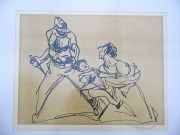
 These were some typical offerings.
These were some typical offerings.
I hated it. Yes it’s serious. Yes it’s recent. Yes they did it too. Yes they’re bastards. But I hated it. I was fed up with the wallowing, the malady in the collective unconscious or whatever it is that is fed and given succour every day. I looked outside just to make sure the sun was still shining. We caught the bus back into town and had three fabulous hours chatting in the sun and watching one version at least of Serbia get on with life.
•• •• •• ••
The best known Serb in the world is not Slobodan Milosevic. The best known Serb in the world is Novak Djokovic, ‘The Joker’; urbane, charming, articulate; spruiker for the importance of family life, apparently delightful company.
I watched him play Roger the other night. What a match. What masters of their craft they both are. It wasn’t because no one will be allowed to beat the Serbs again that Novak won, but I thought I saw in those glinting eyes and the ferocious concentration and the determination not to lose … well, what did I see?
This sign is above his mum and dad’s restaurant.

